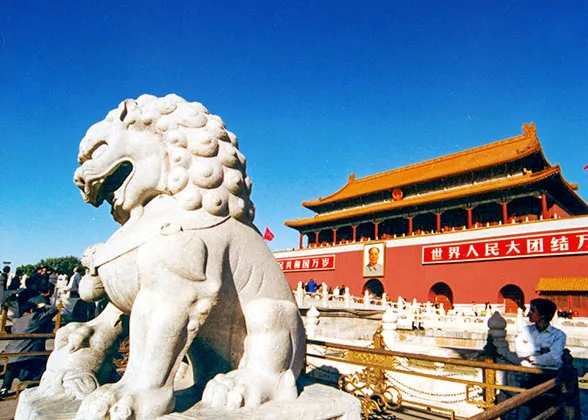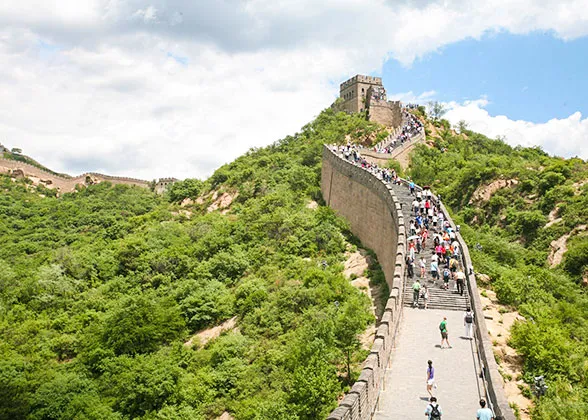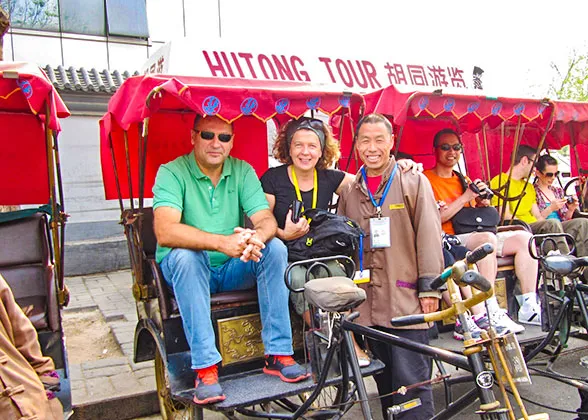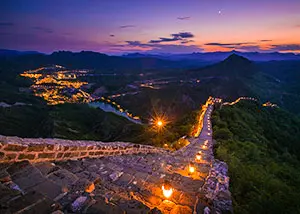Top 10 Beijing Historical Sites You Should Not Miss
Beijing, with a history of more than 3,000 years, is the ancient capital of the Six Dynasties, including that of Ming and Qing Dynasties (1368 – 1911), the closest dynasties to the present. Hence, there are a large number of historical sites in Beijing, from royal palaces to folk houses, imperial gardens to princes’ mansions, ancient colleges to religious temples… Here are top 10 Beijing historical sites you should not miss.
As the most famous historical site in Beijing, the Forbidden City with a history of 600 years was the royal palace of 24 emperors of Ming and Qing Dynasties. The complete and large-scale wooden architectural complex and numerous cultural relics have always been a must for foreign visitors to Beijing. These magnificent buildings are divided into two parts - the outer court and the inner court. The outer court was the place where the emperors dealt with state affairs while the emperors and his families lived in the inner court. Millions of cultural relics in the Forbidden City are displayed either in their original palace or gathered together for better preservation. Among them, the Treasure Gallery and the Gallery of Clocks are eye-catching.
 Recommended Tour:
Recommended Tour:  3 Days Beijing Tour with Forbidden City from $419
3 Days Beijing Tour with Forbidden City from $419
 Book a Forbidden City Ticket
Book a Forbidden City Ticket
The tall, solid and long Great Wall was a military defense project in ancient China to protect the central China from the invasions of the northern nomads. Its earliest construction could be dated back to the 7th Century BC while the most existing parts were built in the Ming Dynasty (1368 - 1644). Its total length from different dynasties is up to 21,196.18 kilometers (13,170.70 miles). The high walls, watchtowers and passes are the main parts of the Great Wall. Among the existing sections, those in Beijing are the best preserved and among the most popular historical places, including Badaling, Mutianyu, Juyongguan, Jinshanling and Simatai. Badaling Great Wall is the essence of the Great Wall while the Mutianyu Great Wall is loved by foreign tourists because of its beautiful natural scenery and less touristy environment. If you plan to hike the Great Wall, you can choose the Jinshanling and Simatai Great Wall.
 Recommended Tour:
Recommended Tour:  Beijing Days Tour with Great Wall from $129
Beijing Days Tour with Great Wall from $129
Located in the western suburb of Beijing, the Summer Palace is a royal garden combining picturesque scenery and grand architecture. Nearly 300 years old, the palace was built on Longevity Hill and Kunming Lake, and is divided into three areas: the court area with the Hall of Benevolence and Longevity as the center, the emperors and empresses living area with Hall of Jade Ripples and Hall of Joyful Longevity as the main body and the tourism area. There are more than one hundred and three thousand ancient buildings including pavilions, terraces, open halls and corridors elaborately scattered inside. The Long Corridor, Seventeen-Arch Bridge, Suzhou Street, Hall that Dispels the Clouds and Tower of the Fragra are highlights. Besides, boating on Kunming Lake is also one of must-do projects.
 Recommended Tour:
Recommended Tour:  2 Days Beijing Mini Group Tour with Summer Palace from $179
2 Days Beijing Mini Group Tour with Summer Palace from $179
 Book a Summer Palace Ticket
Book a Summer Palace Ticket
The Temple of Heaven is a place for emperors of Ming and Qing Dynasties (1368 - 1911) to worship heaven and pray for good harvest. It was first built in 1420, and then expanded and rebuilt by the later emperors, being one of the famous Beijing historical sites to visit. With a total area of 273 hectares (1.05 square miles), the whole temple is divided into two parts, the inner altar and the outer altar. The Hall of Prayer for Good Harvest, the central building of the inner alter and the whole temple, is used to pray for a bumper harvest year. And the Circular Mound Altar in the south is the place where the Heaven Worship Ceremony is held during Winter Solstice. Both of them are the main buildings of the Temple of Heaven and connected by a corridor above the ground - the Danbi Bridge. The other famous buildings are the Imperial Vault of Heaven, Palace of Abstinence and Divine Music Administration. This historical site in Beijing also highlights the Echo Wall, Three Echo Stones and the Dialogue Stone where visitors can hear their own echoes.
 Recommended Tour:
Recommended Tour:  Beijing Mini Group Tours with Temple of Heaven from $89
Beijing Mini Group Tours with Temple of Heaven from $89
The Yonghe Temple was originally the residence of Emperor Yongzheng, the sixth emperor of Qing Dynasty (1636 - 1912), and then turned into a Gelug Temple of Tibetan Buddhism by his son Emperor Qianlong. It has a history of more than 300 years. While visiting, you will find many halls, corridors, pavilions, rooms, porches, terraces, open halls in the eastern area. The middle area gathers the main temples and palaces featuring a multi-ethnic artistic style of Manchu, Han, Tibetan and Mongolian. Hall of Harmony and Peace, Hall of Everlasting Protection, Hall of the Wheel of the Law and Pavilion of Ten Thousand Happinesses are the major palaces. In addition, there are a large number of Buddha statues, thangkas and precious cultural relics in each hall of the temple. Among them, the five hundred arhat mountain carved with red sandalwood, Buddha niche made of phoebe and 18-meter high Buddha with the white sandalwood as raw material are famous for their magnificence, strangeness and refinement.
Located near Shichahai, Prince Gong's Mansion is a well preserved building complex in China and the largest prince’s mansion in Qing Dynasty (1636 - 1912). It was successively the residence of Heshen, a notorious corrupt official in the reign of Qianlong Emperor and the Prince Yongxuan. Later, it got the name of Prince Gong's Mansion after Prince Gong lived here. Covering an area of about 30,000 square meters (35,900 square yards), it has more than 30 various architectural communities. The Mansion is composed of two parts: the front residential area and the back garden. The residential area consists of the middle, eastern and western areas with an axis running through. Each area has three courtyards, the living rooms mainly in the middle area. Jincui Yuan, the back garden in the north of the mansion occupies an area of more than 28,000 square meters (33,500 square yards) and has 31 ancient buildings. It takes the Chinese character “Fu” which means blessing in English as the theme. The Western-Style Gate, the Grand Theater House and the “Fu” Stele are said to be the three great uniqueness of the garden.
7
Temple of Confucius and Guozijian
If you want to find a Beijing historical place to learn Confucism, then you should not miss the Temple of Confucius in Beijing and Guozijian. The two are next to each other. Built in Yuan Dynasty (1271 - 1368), the Temple of Confucius in Beijing was used to worship Confucius who was a great educator, thinker and founder of Confucianism in ancient China. It preserves rare architecture of Yuan Dynasty (1271 - 1368) in Beijing ranging from a great number of stone inscriptions to stone tablets bearing the name of scholars and a forest of steles engraved with the thirteen Confucian classics. Besides, a traditional ritual dance performance in the Chongsheng Temple is excellent.
Guozijian is the highest educational institution in the three dynasties of Yuan, Ming and Qing. During the Ming and Qing Dynasties, Guozijian was established in Nanjing and Beijing respectively. The Beijing Guozijian was built in 1287 and covers an area of more than 27,000 square meters (32292 square yard). In this spot, such distinctive buildings as the Jixian Gate, Taixue Gate and Glazed Memorial Archway deserves a look. It is very special that the Biyong Hall, the main part of the Imperial College, is surrounded by a round pool while the hall is square. The emperors once gave lectures in the Linlun Hall next to it.
Guozijian is the highest educational institution in the three dynasties of Yuan, Ming and Qing. During the Ming and Qing Dynasties, Guozijian was established in Nanjing and Beijing respectively. The Beijing Guozijian was built in 1287 and covers an area of more than 27,000 square meters (32292 square yard). In this spot, such distinctive buildings as the Jixian Gate, Taixue Gate and Glazed Memorial Archway deserves a look. It is very special that the Biyong Hall, the main part of the Imperial College, is surrounded by a round pool while the hall is square. The emperors once gave lectures in the Linlun Hall next to it.
The Old Summer Palace is a large royal palace built by the emperors of the Qing Dynasty (1636 - 1912). Its construction lasted for 150 years from 1709 on, covering an area of 350 hectares (1.35 square miles), with a building area of nearly 160,000 square meters (191,358 square yards). Before it was destroyed in the wars, the Old Summer Palace had more than 600 main gardens, architecture and numerous open halls, pavilions, terraces and winding corridors. There were also rockeries, lakes and winding rivers dotting among these buildings. They embodied the essence of a Chinese classical garden. Although it is now a ruined historical site in Beijing, we can look through the debris to find its spectacular architecture structure and stunning natural landscape. The Old Summer Palace consists of Yuanmingyuan, Changchunyuan and Qichunyuan. There are many small waterscape gardens in Qichunyuan. Lotus flowers in full bloom in Qichunyuan from June to August is another highlight. Changchunyuan is dominated by large artificial fountains which is characterized by large quantity, great momentum and unique designs. The most famous one is the Grand Waterworks. Other popular scenic spots in the Old Summer Palace are the Throne for Viewing the Waterworks and the Labyrinth.
Located in the northwest suburb of Beijing, the Ming Tombs is one of the largest imperial tomb groups in China. Thirteen emperors of the Ming Dynasty (1368 - 1644) are buried here. Each tomb is built in front of a mountain. The distance between the tombs is from half a kilometer to eight kilometers. Except Siling Tomb in the southwest corner, the other tombs are fan-scattered around Changling Tomb. At present, visitors can only visit Changling Tomb, Dingling Tomb, Zhaoling Tomb and the Sacred Way guarded by various stone figures and stone animals on two sides. In addition, visitors can appreciate various cultural relics unearthed in Changling Museum, such as phoenix coronets, civilian official’s hats, men's jade belts and hairpins.
The Peking Man Site is located about 50 kilometers (31 miles) southwest of Beijing city. 70 million years ago, the ancestors of human beings had been living here, so it is one of the oldest historical places in Beijing. In Peking Man Site at Zhoukoudian, 27 sites of various kinds of fossils and cultural relics of different periods have been found, including more than 200 human fossils, more than 100,000 stone tools, a large number of fire use relics and hundreds of animal fossils. A new Zhoukoudian Site Museum is just situated about 500 meters (550 yards) to the south of Zhoukoudian Site. There are more than 7,000 cultural relics in collection and more than 1,000 cultural relics on display.
You May Like
- Last updated on Aug. 29, 2024 by Gabby Li -



